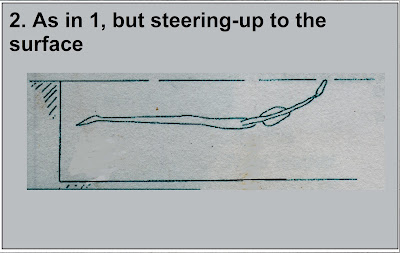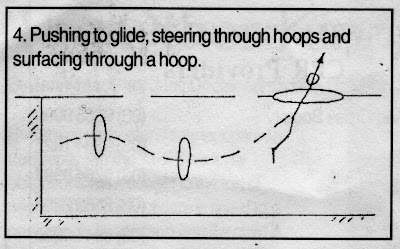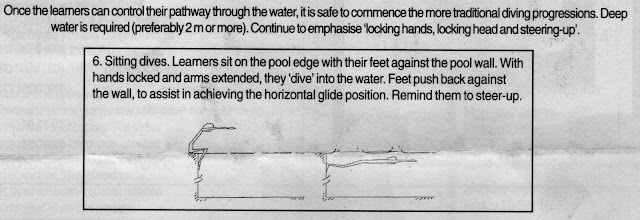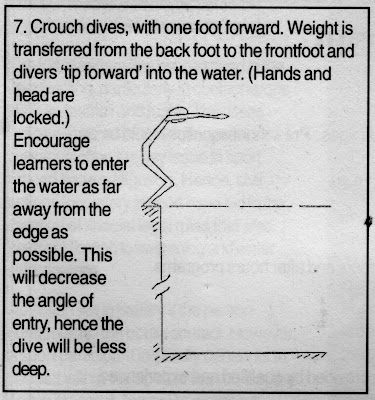Teaching Safe Diving Skills is Vital
This article is reprinted from the "Water Babble" issue of May 2001 and is 'Cop Con' as it was not possible to obtain permission.
Teaching safe diving skills is an important step toward decreasing the risk of diving spinal cord injury.
Each year about 25 young Australians sustains spinal cord injuries from diving and other water-related activities (Cripps O'Conner, 1998). The typical casualty is an athletic male aged between 15 and 29 (Young et al., 1982) with self-taught diving skills (Gabrielsen & Spivey, 1990, cited in DeMers, 1994), and unaware of the dangers associated with diving into shallow water and the skills required to perform a 'low dive entry. Alcohol is often a factor (Buke 1972; Green et al 1987; Brunch et al 1991; Scher;1981:1992).
Diving injury frequently affects the spine at level C5/6 usually causing tetraplegia (paralysis of all limbs) (Kunzke, 1975; Beiring-Sorrenson et al., 1990; Damian & Turk,1995). Those who become tetraplegic remain dependent on others for the rest of their life. The physical and emotional devastation and me ongoing financial costs of diving injuries must be addressed by prevention programs (Blanksby et al., 1997).
As swimming teachers and coaches, we can take steps to improve the diving skill level of our charges and increase awareness of the potential dangers of diving. We should emphasise that diving is just one way to enter the water, and perhaps the least protected from a safety perspective (Blanksby et al, 1997). A dive entry should only be used when the condition of the water is known to be deep and free of obstacles. Slide-in and wade-in entries are the only safe ways to enter the water when the depth and presence of obstacles are unknown.
Wait... Get Your Lesson Plans Here
Because a high proportion of those injured through diving is self-taught, minimally educated divers, the University of Ballarat Aquatic Research team considered that a combination of educational awareness and improved diving skill would assist in the prevention of diving spinal cord injuries. An innovative skills program of seven 10- minute sessions was developed, emphasising hand and arm position (locking hands together beyond the head) which protects the head from impact, and 'steering-up' to the water surface, which helps to minimise dive depth. Initially, 'steering-up' skills were taught in a glide position without a dive entry, allowing learners to experiment with the effect of different body positions on the pathway of the body without the risk of a diving injury (see figures 1-5). Plastic hoops and foam noodles were used as teaching aids. Simplified traditional 'learn-to-dive' sequences were implemented only after spending time on various activities designed to develop steering skills (see figure 6-8). Participants in the program were 'recreational level' swimmers, rather than skilled competitors. This was considered important as diving injuries are rare in competitive swimmers but much more likely among recreational swimmers.
To assess the effectiveness of the "Teaching Safe Diving skills" program, the University of Ballarat research team evaluated the diving skill levels of participants immediately after the program, then 8 and 20 months later. After the short intervention (total time of 70 minutes) dives were significantly safer. It was particularly encouraging that skills were successfully retained over the 8 and20 month non-practice periods. The improved diving skill levels of learners and their increased awareness of the risk inherent in diving which resulted from participation in the program are both vital steps towards decreasing the risk of aquatic spinal cord injury.
For further information on safe diving, contact Dr Jenny Blitvich at the University of Ballarat (03)53279690 or email j.blitvich@ballarat.edu.au, or attend one of the VlCSWlM or Unisports Ballarat 'Teaching Safe Diving' workshops.
The following figures show the basic progressions of the program. Learners must have their hands locked and their arms extended throughout the glide phase in all activities. Hands must not separate until learners have reached the surface. Teachers must ensure they continually emphasise hand and arm position.
 |
| Fig. 1: Pushing off the wall |
 |
| Fig. 2: Steering Up To The Surface |
|
 |
| Fig.3: Steering Down |
 |
| Fig.4: Steering Through The Hoops |
|
 |
| Fig.5: Pushing Off The Bottom With Noodles And Hoops |
|
 |
| Fig.6: Steering Through The Hoops |
|
Enjoy
Richard










No comments:
Post a Comment